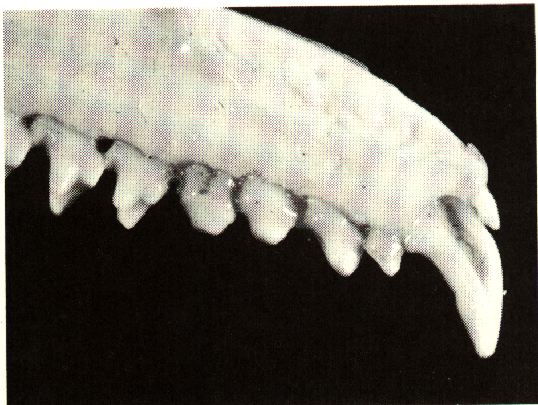
Adapted from:
The International Wildlife Encyclopedia,
Funk & Wagnalls, Inc., New York, 1974
Solenodon
The two species of solenodon were first discovered by Europeans in 1833 on the islands of Hispaniola and Cuba. They are shrew-like creatures with an even more antiquated look about them than the true shrews. Fossil evidence shows that they were in existence 30 million years ago in North America. They seem therefore to be primitive insectivores¤survivors from the past that have managed to hang on in these two islands because there are so few natural enemies there.
Solnodons are a foot long, with a tail up to 10 in. They have
stout bodies with a disproportionately large head, made to look
the more ungainly because of the unusually long snout. In most
animals the snout forms a cushion of flesh just in front of the
tips of the nasal bones. In solenodon, as in some other insectivores,
there is a rod of cartilage, or gristle, in front of the nasals,
supporting its unusually long snout. There are many long bristles
on the face, the eyes are very small, the ears partly naked and
mostly hidden in the fur. The coat is blackish to reddish brown,
paler on the underside. The tail is nearly naked and so are the
legs and the large feet each with five toes bearing large, strong
claws. The especially large forefeet have larger and more curved
claws than those on the hindfeet.
No straight path
One reason why it was so long before scientists got to know of solenodons is that they are nocturnal. They are also not very numerous. During the day they lie up in burrows, in hollow trees and logs or in caves, well out of sight. When they do come out they run on their toes with a stiff ungainly waddle, following an erratic almost zigzag course. The local people claim that
solenodons never run in a straight line. Moreover, when a solenodon
is alarmed and tries to put on speed it is as likely as not to
trip over its own toes or even tumble head-- over-heels. Like
some of the shrews which they resemble, although they are not
closely related to them, they have a poisonous saliva. The second
incisor on each side in the lower jaw is grooved. Indeed, solenodon
means grooved tooth. At the base of each of these incisors is
a gland from which the poison runs along the groove in each tooth.
When solenodons fight in captivity the light wounds inflicted
are fatal.
Dying out in the midst of plenty
Solenodons eat a wide variety of animal and plant foods, such as insects, worms and small invertebrates generally, as well as small reptiles. I hey also eat roots, fruits and leaves. They root in the ground with their long snouts, dig with their stout claws or rip open rotten logs. Solenodons in captivity have been seen to bathe often and to drink only when bathing. Perhaps the long snout makes any other way difficult. For animals with such habits there is no shortage of food but solenodons are be coming. more and more rare. This is partly

A Solenodon skull showing grooved second incisor which the poisonous
saliva flows.

Haitian solenodon; this primitive insectivore is still present in areas of stony forest in the northeastern area of Haiti.
due to their slow rate of breeding. The female may have two litters
a year of 1-3 young but she has only two teats in an unusual position¤almost
on the buttocks!
Doomed
As well as having a poisonous bite a solenodon has glands in the
armpits and in the groin, which give off a goat-like smell. It
readily defends itself against one of its own kind, and probably
attacks other animals savagely judging from the way a captive
solenodon attacked a young chicken and tore it to pieces with
its strong claws, before eating it. In moments of excitement it
may grunt like a pig or give bird-like cries. but when pursued
it stays motionless and hides its head, so it can be picked up
easily. Taking all these facts together the solenodon is a slow
mover, clumsy runner, with no agility in avoiding enemies and
poor means of defence. As a result, once dogs and cats were taken
to its island homes, and especially when mongooses were introduced,
its future began to look black. Probably the only way of saving
it would be to set up reserves, but this is hardly practical on
(Cuba or Hispaniola today, and tomorrow may be too late. Although
we speak about what solenodons in captivity have done, these are
only random observations and the number of animals that have found
their way to zoos is very small: at the last count in June 1969
10 Haitian solenodons were to be found in 5 zoos throughout the
world. No Cuban ones are in captivity as far as is known.
| class | Mammalia |
| order | Insectivora |
| family | Solenodontidae |
| genus & species | Solenodon cubanus
Cuban solenodon S. paradoxus Haitian solenodon |